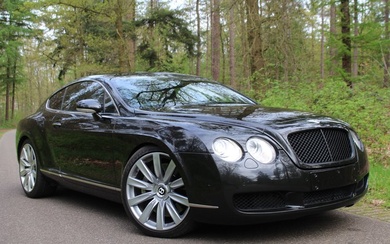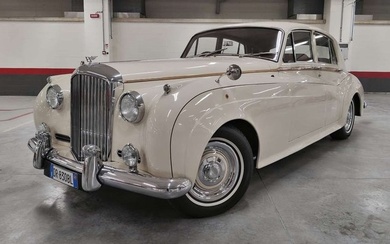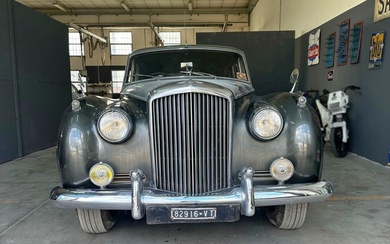Property of a deceased's estate 1927 Bentley 3-Litre Sports Project
1927 Bentley 3-Litre Sports Project
Registration no. YF 2654
Chassis no. TN1566
Engine no. TN1567
• Originally an Offord-bodied coupé
• Matching chassis and engine
• Family owned since March 1957
• Garaged unused for some 50-plus years
• 'Barn find' offered for restoration
With characteristic humility 'W O' was constantly amazed by the enthusiasm of later generations for the products of Bentley Motors Limited, and it is testimony to the soundness of his engineering design skills that so many of his products have survived. From the humblest of beginnings in a mews garage off Baker Street, London in 1919 the Bentley rapidly achieved fame as an exciting fast touring car, well able to compete with the best of European and American sports cars in the tough world of motor sport in the 1920s. Bentley's domination at Le Mans in 1924, 1927, 1928, 1929 and 1930 is legendary, and one can only admire the Herculean efforts of such giants as Woolf Barnato, Jack Dunfee, Tim Birkin and Sammy Davis, consistently wrestling the British Racing Green sports cars to victory.
W O Bentley proudly unveiled the new 3-litre car bearing his name on Stand 126 at the 1919 Olympia Motor Exhibition, the prototype engine having fired up for the first time just a few weeks earlier. Bentley's four-cylinder 'fixed head' engine incorporated a single overhead camshaft, four-valves per cylinder and a bore/stroke of 80x149mm. Twin ML magnetos provided the ignition and power was transmitted via a four-speed gearbox with right-hand change. The pressed-steel chassis started off with a wheelbase of 9' 9½", then adopted dimensions of 10' 10" ('Standard Long') in 1923, the shorter frame being reserved for the TT Replica and subsequent Speed Model. Rear wheel brakes only were employed up to 1924 when four-wheel Perrot-type brakes were introduced.
In only mildly developed form, this was the model that was to become a legend in motor racing history and which, with its leather-strapped bonnet, classical radiator design and British Racing Green livery, has become the archetypal Vintage sports car.
Early success in the 1922 Isle of Man Tourist Trophy, when Bentleys finished second, fourth, and fifth to take the Team Prize, led to the introduction of the TT Replica (later known as the Speed Model and identified by the Red Label on its radiator ) on the existing 9' 9½" wheelbase, short standard chassis. Bentley had made approximately 1,600 3-Litre models when production ceased in 1929, the majority of which were bodied by Vanden Plas with either open tourer or saloon coachwork.
Dr Clare Hay's authoritative work, Bentley, The Vintage Years, records the fact that chassis number 'TN1566' (with engine number '1567') was completed in April 1927 on the long standard 10' 10" wheelbase chassis with coupé coachwork by Offord. Hay records that 'TN1567' was first owned by one W A Thompson and registered as 'YF 2654', noting: "Now 2 seater on 9' 0" wheelbase." It is not known when this modification was carried out.
The next ownership record we have is an old-style buff logbook issued on 1st June 1950 listing four owners: Arthur Ratcliffe Ainsworth of Dorking; A B B Woodburn of Bolesworth; Bursledon Autos of Sholing; and one Miss Mary Louisa White, BSc, who registered the Bentley on 2nd March 1957. Miss White appears to have been a most enthusiastic owner, a view supported by the numerous Bentley Drivers Club membership cards on file, mostly dating from the late 1950s to the mid 1970s, while there are also some spectator's passes, an RAC membership card and a VCC official's badge. According to the deceased's family, Miss Mary Louisa White passed away in 2005 and was the last known person to drive the Bentley in the late 50s or early 60s. 'YF 2654' was then left to Miss Nicola White, (the last recorded keepers' niece) along with the property where the Bentley was kept. Miss Nicola White passed away in July 2023.
Additional documentation includes assorted correspondence, sundry bills, insurance paperwork, a later buff logbook (1963), an old-style V5 registration document, and four MoT certificates, the most recent of which was issued in 1964. The most recent tax discs on file date from the 1960s, so it seems reasonable to conclude that the Bentley was taken off the road sometime towards the end of that decade. It has remained in the owner's garage ever since, concealed beneath a variety of non-Bentley-related clutter, and is presented in 'barn find' condition, ripe for sympathetic restoration. Sold strictly as viewed, 'YF 2654' represents a wonderful opportunity to bring a long-forgotten 'W O' Bentley back to life.
View it on
Sale price
Estimate
Time, Location
Auction House
1927 Bentley 3-Litre Sports Project
Registration no. YF 2654
Chassis no. TN1566
Engine no. TN1567
• Originally an Offord-bodied coupé
• Matching chassis and engine
• Family owned since March 1957
• Garaged unused for some 50-plus years
• 'Barn find' offered for restoration
With characteristic humility 'W O' was constantly amazed by the enthusiasm of later generations for the products of Bentley Motors Limited, and it is testimony to the soundness of his engineering design skills that so many of his products have survived. From the humblest of beginnings in a mews garage off Baker Street, London in 1919 the Bentley rapidly achieved fame as an exciting fast touring car, well able to compete with the best of European and American sports cars in the tough world of motor sport in the 1920s. Bentley's domination at Le Mans in 1924, 1927, 1928, 1929 and 1930 is legendary, and one can only admire the Herculean efforts of such giants as Woolf Barnato, Jack Dunfee, Tim Birkin and Sammy Davis, consistently wrestling the British Racing Green sports cars to victory.
W O Bentley proudly unveiled the new 3-litre car bearing his name on Stand 126 at the 1919 Olympia Motor Exhibition, the prototype engine having fired up for the first time just a few weeks earlier. Bentley's four-cylinder 'fixed head' engine incorporated a single overhead camshaft, four-valves per cylinder and a bore/stroke of 80x149mm. Twin ML magnetos provided the ignition and power was transmitted via a four-speed gearbox with right-hand change. The pressed-steel chassis started off with a wheelbase of 9' 9½", then adopted dimensions of 10' 10" ('Standard Long') in 1923, the shorter frame being reserved for the TT Replica and subsequent Speed Model. Rear wheel brakes only were employed up to 1924 when four-wheel Perrot-type brakes were introduced.
In only mildly developed form, this was the model that was to become a legend in motor racing history and which, with its leather-strapped bonnet, classical radiator design and British Racing Green livery, has become the archetypal Vintage sports car.
Early success in the 1922 Isle of Man Tourist Trophy, when Bentleys finished second, fourth, and fifth to take the Team Prize, led to the introduction of the TT Replica (later known as the Speed Model and identified by the Red Label on its radiator ) on the existing 9' 9½" wheelbase, short standard chassis. Bentley had made approximately 1,600 3-Litre models when production ceased in 1929, the majority of which were bodied by Vanden Plas with either open tourer or saloon coachwork.
Dr Clare Hay's authoritative work, Bentley, The Vintage Years, records the fact that chassis number 'TN1566' (with engine number '1567') was completed in April 1927 on the long standard 10' 10" wheelbase chassis with coupé coachwork by Offord. Hay records that 'TN1567' was first owned by one W A Thompson and registered as 'YF 2654', noting: "Now 2 seater on 9' 0" wheelbase." It is not known when this modification was carried out.
The next ownership record we have is an old-style buff logbook issued on 1st June 1950 listing four owners: Arthur Ratcliffe Ainsworth of Dorking; A B B Woodburn of Bolesworth; Bursledon Autos of Sholing; and one Miss Mary Louisa White, BSc, who registered the Bentley on 2nd March 1957. Miss White appears to have been a most enthusiastic owner, a view supported by the numerous Bentley Drivers Club membership cards on file, mostly dating from the late 1950s to the mid 1970s, while there are also some spectator's passes, an RAC membership card and a VCC official's badge. According to the deceased's family, Miss Mary Louisa White passed away in 2005 and was the last known person to drive the Bentley in the late 50s or early 60s. 'YF 2654' was then left to Miss Nicola White, (the last recorded keepers' niece) along with the property where the Bentley was kept. Miss Nicola White passed away in July 2023.
Additional documentation includes assorted correspondence, sundry bills, insurance paperwork, a later buff logbook (1963), an old-style V5 registration document, and four MoT certificates, the most recent of which was issued in 1964. The most recent tax discs on file date from the 1960s, so it seems reasonable to conclude that the Bentley was taken off the road sometime towards the end of that decade. It has remained in the owner's garage ever since, concealed beneath a variety of non-Bentley-related clutter, and is presented in 'barn find' condition, ripe for sympathetic restoration. Sold strictly as viewed, 'YF 2654' represents a wonderful opportunity to bring a long-forgotten 'W O' Bentley back to life.







